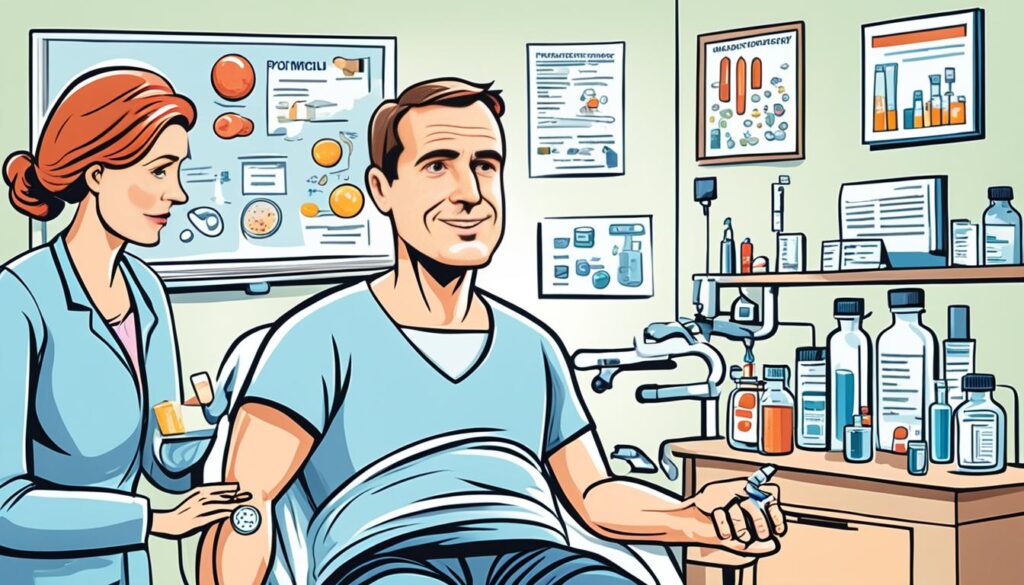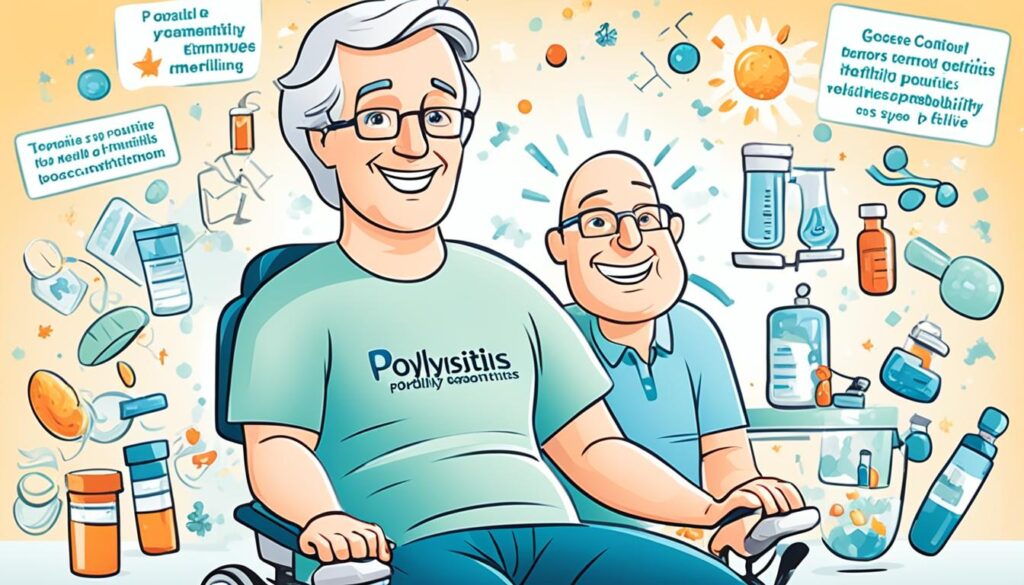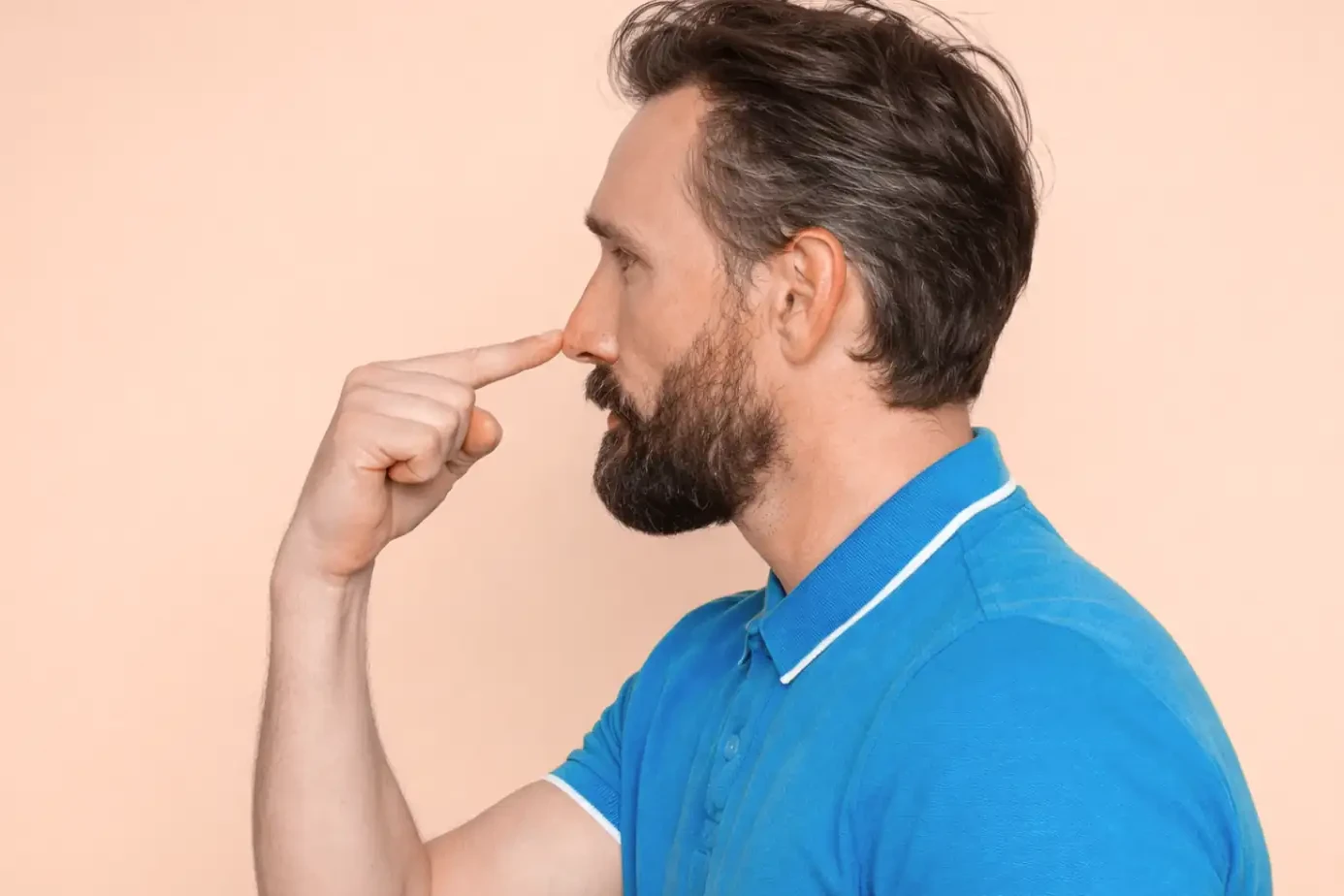Polymyositis is a rare condition that weakens muscles due to inflammation. This article focuses on how to treat it effectively. We’ll look at both medical polymyositis treatment and changes to your lifestyle. These will help you handle polymyositis better and enjoy life more.
We will cover what polymyositis is, its symptoms, how it’s diagnosed, and the available medicines. You’ll learn about the benefits of physical and speech therapy. We’ll also talk about how to deal with any complications that might come up.
If you’ve just been diagnosed or have lived with polymyositis for a while, this guide is for you. It will give you the info you need to team up with your doctors. Together, you can take steps to manage your care effectively.
Table of Contents
ToggleWhat is Polymyositis?
Overview of the Condition
Polymyositis is a rare autoimmune disorder. It causes inflammation and weakness in skeletal muscles. This condition is part of a group known as idiopathic inflammatory myopathies.
The cause is not clear. It seems like the immune system attacks the body’s muscles by mistake. This can happen at any age but is most common in people between 50 and 70 years old.
It affects women more than men. It is also seen more in Black people than White people. Polymyositis is rare, with only about 1 in 100,000 being affected.
Causes and Risk Factors
The cause of polymyositis is not well understood, but it seems to be linked to the immune system attacking muscles by mistake. Certain things might make you more likely to get it. These include:
– A family history of the condition might increase your risk.
– Viruses, medications, or other factors could lead to the immune system attacking the muscles.
– It might also show up with other autoimmune diseases, like lupus or mixed connective tissue disease.
– In older adults, having certain types of cancer has been linked to polymyositis.

Symptoms of Polymyositis
Muscle Weakness and Pain
With polymyositis, you might first notice that your muscles near your core are weak. These are the muscles of your shoulders, hips, and thighs. This weakness can make simple tasks hard, like climbing stairs or standing up. If you have this disease, you might find it tough to put your arms up. The weakness can come on slowly over time, or quickly in some cases.
Along with this weakness, you could feel pain or tenderness in your muscles. Sometimes, this pain is similar to other diseases, like polymyalgia rheumatica.
Other Associated Symptoms
Polymyositis’s effects don’t stop at muscle weakness and pain. Other symptoms can also show up. These include:
- Difficulty swallowing (dysphagia) and speaking (dysphonia) due to weakness of the throat and upper esophageal muscles
- Feeling out of breath and having trouble with your breathing due to chest muscle weakness
- Heart issues like arrhythmias or congestive heart failure
- Raynaud’s phenomenon, which affects the blood supply to the fingers and toes
- Non-erosive arthritis
- General symptoms like being tired, having a fever, or losing weight
Diagnosing Polymyositis
Diagnosing polymyositis involves your medical background, physical checks, and specific tests. Blood tests are a big part. They check for high levels of certain enzymes that show muscle damage. Autoantibodies linked to polymyositis can also be found in these tests, helping with polymyositis treatment choices.
Electromyography (EMG)
EMG checks the electrical work in muscles. It uses a needle electrode placed in a muscle. For people with polymyositis, an EMG might find certain issues. These can suggest muscle swelling and harm.
Magnetic Resonance Imaging (MRI)
MRI takes detailed pictures and helps diagnose polymyositis. It finds muscle swelling and water build-up. This highlights the muscle to biopsy. MRI also shows how much your muscles are affected. This is key in tracking the disease’s course and how well polymyositis treatment work.
Muscle Biopsy
Getting a muscle biopsy is crucial for a polymyositis diagnosis. A small piece of muscle is taken and looked at under a microscope. This shows signs of the disease, like inflammation and damage. It helps confirm the diagnosis and rule out other conditions.

Medical Polymyositis Treatment Options
Polymyositis is mainly treated with medicines. These control the body’s wrong attack and boost muscle power. Prednisone, a corticosteroid, is usually the first choice. It fights muscle swelling and boosts muscle work.
But, using prednisone for a long time can bring big problems. So doctors slowly lessen the dose as the patient gets better.
Corticosteroids
Sometimes, prednisone isn’t enough. Then, other medicines are added. These are drugs like azathioprine and methotrexate. They fight more of the body’s attack.
Using these with prednisone allows a lower prednisone dose. This helps lower side effects.
Immunosuppressants
Another choice is IVIg. It’s made from healthy blood and contains strong antibodies from many people.
These help stop the bad antibodies attacking muscles in polymyositis. The treatment is often given through an IV drip and may be repeated.
Intravenous Immunoglobulin (IVIg)
The main treatment for polymyositis uses medicines to handle the wrong immune attack and boost muscles. Prednisone is the go-to medication. It eases muscle swelling and improves function.
Yet, long-term prednisone use can have harsh effects. So, doctors lessen the dose slowly as the patient improves.

Polymyositis treatment
Physical therapy is vital in handling polymyositis. A therapist will set up exercises for you. These workouts will boost your muscle strength and flexibility. Your therapist will guide you to avoid straining muscles while helping them to recover and grow.
Physical Therapy
Polymyositis can affect throat and swallowing muscles, making it hard to eat or talk. A speech therapist helps by teaching new ways to eat and speak. They use exercises and strategies to improve how you communicate.
Speech Therapy
As the disease gets worse, eating and swallowing can be tough. A dietitian can create a plan with foods easy to eat and full of nutrients. This plan ensures you get the proper energy and health support.
Dietary Modifications

Managing Complications
Polymyositis sometimes affects important breathing muscles. This can cause issues like shortness of breath and more lung infections. It might also make it hard for you to breathe well on your own.
Your healthcare team will keep a close eye on you. They might need to use tools like oxygen masks or special machines to help you breathe if it gets difficult.
Another issue with polymyositis is heart trouble. This can lead to heart rhythm problems, heart muscle inflammation, and a condition called congestive heart failure. At first, you might not feel these heart problems. But they can get worse if not taken care of.
It’s really important to regularly check how your heart is doing. This includes tests like electrocardiograms and echocardiograms. Extra care, like medicines or even heart surgery, may be needed if heart issues show up.

Prognosis and Disease Course
For those with polymyositis, the outlook differs. Yet, with quick and proper care, around 95% can expect to live five more years. Still, about a third may experience muscle weakness even after they’ve been treated successfully.
The course of polymyositis can swing wildly. Sometimes, symptoms get worse; then, miraculously, they get better. Starting treatment early and hitting it hard from the get-go are crucial steps. They help in achieving the best results and reduce the chances of long-term health issues or a drop in your quality of life.
Living with Polymyositis
Living with polymyositis is tough on your body and mind. It’s key to find ways to cope. This helps you handle daily struggles and keeps you well. Some coping strategies that can help include:
– Learning about the condition’s ins and outs
– Being an active part of your health decisions
– Balancing activities with enough rest
– Keeping a positive vibe and getting help from loved ones
– Finding and connecting with others in the same boat by joining a support group
Coping Strategies
It’s priceless to link up with others dealing with polymyositis. Support groups online and in person let you swap stories, tips, and emotional backing. They ward off loneliness, creating a community vibe. Look into what national and local groups offer for extra help.
Support Groups
Being part of a support group is a plus for those with polymyositis. It’s a space where you get to talk with folks who truly get it. Together, you can build up on ways to cope and give and receive a shoulder for the struggles.

Polymyositis in Children
Polymyositis in children is rarer than in adults but can happen. Kids with polymyositis show signs like weak muscles and pain. They might also have growth and learning problems.
The way doctors treat kids with polymyositis is much like how they treat adults. They use medicines like corticosteroids and immunosuppressants. They also suggest physical therapy. But, with kids, doctors think about their age and specific needs too.
Polymyositis is not often found in kids under 18. Adults usually get it, mostly between 40 and 50. Even though polymyositis in children is rare, finding it early and treating it can improve the child’s health and growth.
Research and Clinical Trials
Studying polymyositis is key to knowing and treating this rare muscle disease. Doctors look into what causes it and try new treatments. By joining clinical trials, you might get access to the latest therapies and help improve how this condition is handled.
If you have polymyositis, talk to your doctors about trial chances. Keeping up with new research is important. Trials are for people 18 or older with this condition and last about a year. Most people in a trial have a better shot at getting real treatment than a fake one.
You’ll have about 15 check-ups in a year, and can stay in a follow-up study longer. Whether you get the real drug or a placebo is a secret. This is to make the study results fair. You may keep taking some other treatments, but drugs like corticosteroids could change.
Joining a trial is your choice, and you can leave whenever you want without it affecting your health care. Your privacy during the study is safeguarded. Learning more and talking with your health team can help improve how polymyositis is handled for everyone.
Polymyositis and Associated Conditions
Polymyositis can increase the risk of cancer, especially in older people. This is because the body’s immune system, which causes polymyositis, might also lead to cancer. People with polymyositis need to get checked for cancer often. They should tell their doctor about any new or worrying signs. Finding and treating cancer early is very important for those with polymyositis.
Other Autoimmune Disorders
Polymyositis can show up with other autoimmune diseases like lupus, rheumatoid arthritis, and mixed connective tissue disease. Having several autoimmune diseases makes treating polymyositis more complex. It often needs different doctors, like rheumatologists and neurologists, to work together. This team approach helps patients with polymyositis and other autoimmune diseases get the best care.
Preventive Measures
The best way to avoid polymyositis is to keep healthy and manage any health issues you already have. This could lower the chance of getting the condition. Try to stay away from things that can trigger polymyositis, like some medicines or certain infections.
Eating a balanced diet is important for your overall health and muscle health. Doing physical activities that are gentle can also help. It’s also key to keep your stress levels down. Stress can make autoimmune problems like polymyositis worse. Make sure to have regular cancer checks and watch for any health changes if you have or think you might have polymyositis.
No one can promise you won’t get polymyositis. But, by keeping well and following the right health advice, you can do a lot. Working with your doctors to make a health plan just for you is very important. This plan should help you deal with any medical concerns you might have.
When to See a Doctor
If you are facing muscle weakness, pain, or tiredness, see a rheumatologist or neurologist right away. Getting diagnosed early and starting treatment is key. This helps in managing polymyositis and avoiding serious health problems.
Go see a doctor if you have:
– Muscle weakness that doesn’t go away, especially near the trunk
– Trouble with simple tasks like going up stairs or picking up things
– Finding it hard to swallow or talk
– Feeling out of breath or having issues with your breathing
Conclusion
Polymyositis (PM) is a rare autoimmune disorder that affects muscles. It can impact your life greatly. But, with a full treatment that includes medicine and care, life can get better for many with polymyositis. Working closely with your healthcare team, learning more about the condition, and getting involved in your care are key steps. This helps you take charge of living with polymyositis.
There is always hope, thanks to ongoing research. This research helps us understand and treat this muscle disorder better. By getting the right support and using good management methods, you can handle polymyositis well. This makes it possible to still have a good quality of life. Keep learning, ask for what you need, and look for help from support groups and other resources. They offer advice and a community that can be very helpful as you face this condition.
The path forward might seem hard, but you’re not alone. By working closely with your healthcare team and keeping a positive attitude, you can keep moving ahead. This makes managing polymyositis and enjoying life more possible. So, remember, polymyositis is treatable with the right support. You can beat the obstacles it brings.
FAQ
What is polymyositis?
Polymyositis is a rare disorder where the immune system attacks muscles, causing inflammation. This affects mainly the skeletal muscles, which help us move.
What are the underlying causes and risk factors of polymyositis?
The cause of this disorder is unknown, but it’s thought to involve the immune system. It might be triggered by genetics, the environment, or other autoimmune diseases.
What are the primary symptoms of polymyositis?
Polymyositis mainly shows up as muscle weakness in areas close to the body’s core. This includes shoulders, hips, and thighs. Other signs are muscle pain, trouble with simple actions like swallowing, and short breath.
How is polymyositis diagnosed?
Doctors diagnose polymyositis by looking at a patient’s history and doing physical exams. They also use blood tests, EMG, MRI, and sometimes a muscle biopsy.
What are the main treatment options for polymyositis?
Treatment includes corticosteroids, drugs to suppress the immune system, and sometimes IVIg. Physical and speech therapy are important too.
How can complications associated with polymyositis be managed?
Problems like breathing issues or heart complications require careful watch and specific treatments. This might include breathing aids, heart drugs, and special diets.
What is the prognosis for individuals with polymyositis?
With quick and right treatment, most people with polymyositis survive past five years. Yet, some may have lasting muscle weakness.
How can individuals living with polymyositis cope with the challenges of the condition?
To deal with polymyositis, it’s crucial to learn about it and be active in your healthcare. Also, keep a good outlook and get help from loved ones and groups.
Can polymyositis also affect children?
Though rarer, children can get polymyositis. Its treatment is much like for adults, adjusted for a child’s special needs and growth.
How can research and clinical trials contribute to the understanding and management of polymyositis?
Research and trials are vital for improving how we deal with polymyositis. They offer new treatments and insights into better care for this condition.
Can polymyositis be associated with other conditions?
Polymyositis can boost the risk of some cancers and link to other autoimmune diseases. These can make treating it more complex.
Are there any preventive measures for polymyositis?
There aren’t sure ways to prevent polymyositis. But, keeping healthy, managing autoimmune diseases, and avoiding triggers might lower risks.
When should someone seek medical attention for potential polymyositis symptoms?
If muscle weakness, trouble with daily tasks, or other health changes happen, see a doctor quickly. Any concern for polymyositis needs prompt attention.
Source Links
- https://www.mayoclinic.org/diseases-conditions/polymyositis/diagnosis-treatment/drc-20353212
- https://www.ncbi.nlm.nih.gov/pmc/articles/PMC3482800/
- https://emedicine.medscape.com/article/335925-treatment
- https://www.hopkinsmedicine.org/health/conditions-and-diseases/polymyositis
- https://www.mayoclinic.org/diseases-conditions/polymyositis/symptoms-causes/syc-20353208
- https://www.ncbi.nlm.nih.gov/books/NBK563129/
- https://www.ncbi.nlm.nih.gov/pmc/articles/PMC1798355/
- https://www.myositis.org/about-myositis/treatment-disease-management/prognosis/
- https://www.webmd.com/arthritis/polymyositis
- https://www.pfizerclinicaltrials.com/nct05895786-dermatomyositis-or-polymyositis-trial
- https://www.ncbi.nlm.nih.gov/pmc/articles/PMC7955788/
- https://www.urmc.rochester.edu/encyclopedia/content.aspx?contenttypeid=134&contentid=45
About The Author

This article is medically reviewed by Dr. Chandril Chugh, Board-Certified Neurologist, providing expert insights and reliable health information.
Dr. Chandril Chugh is a U.S.-trained neurologist with over a decade of experience. Known for his compassionate care, he specializes in treating neurological conditions such as migraines, epilepsy, and Parkinson’s disease. Dr. Chugh is highly regarded for his patient-centered approach and dedication to providing personalized care.
→ Book a consultation to discover which remedies suit your needs best.




